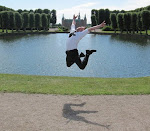.jpg)
The Indian on horseback is riding due south and represents the Indian heritage of Minnesota.
The tools: the Indian’s horse and spear and pioneer’s axe, rifle, and plow represent tools that were used for hunting and labor.
The stump is a symbol of the importance of the lumber industry in Minnesota.
The Mississippi River and St. Anthony Falls are depicted to note the importance of these resources in transportation and industry.
The cultivated ground and the plow symbolize the importance of agriculture in Minnesota.
Trees: beyond the falls, three pine trees represent the state tree and the three great pine regions of Minnesota–St. Croix, Mississippi, and Lake Superior.
[http://www.statesymbolsusa.org/Minnesota/stateSEAL.html]
The original version, drawn by Seth Eastman while Minnesota was still a territory, depicted a Native American galloping east, not west, into the setting sun. The Latin phrase "Quo sursum velo videre" ("I want to see what lies beyond") represented the pioneer heritage of Minnesota, but was unfortunately misspelled. When Minnesota became a state in 1858 the seal was corrected. The Native American was depicted galloping east and the Latin phrase was changed to the state motto "L'Etoile du Nord". When Minnesotans began questioning the depiction of Native Americans on the state seal in the 1960's the seal was changed again. The new seal depicted a white settler, not a Native American, galloping off into the sunset. In 1983 the fourth and current state seal was approved by the legislature. Several state trees (the Norway Pine) were added and the settler on horseback was replaced with a Native American on horseback galloping toward the farmer.
[http://www.mnsu.edu/]







No comments:
Post a Comment